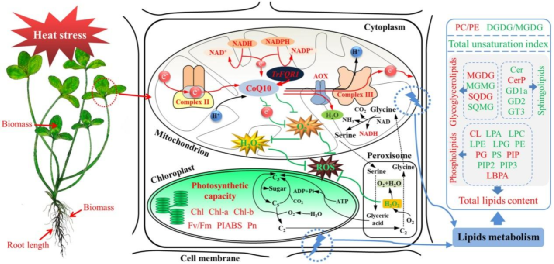A Trifolium repens flavodoxin-like quinone reductase 1 (TrFQR1) improves plant adaptability to high temperature associated with oxidative homeostasis and lipids remodeling
2023年04月04日 10:15
DOI: doi.org/10.1111/tpj.16230
发表期刊:The Plant Journal
链接:https://doi.org/10.1111/tpj.16230
作者:Bizhen Cheng†,1, Min Zhou†,1, Tao Tang †,1, Muhammad Jawad Hassan, Jianzhen Zhou, Meng Tan, Zhou Li*,1, Yan Peng*,1
Abstract: Maintenance of stable mitochondrial respiratory chain could enhance adaptability to high temperature, but potential mechanism was not elucidated clearly in plants. In this study, we identified and isolated a TrFQR1 gene encoding the flavodoxin-like quinone reductase 1 (TrFQR1) located in mitochondria of leguminous white clover (Trifolium repens). Phylogenetic analysis indicated that amino acid sequences of FQR1 in various plant species showed high degree of similarities. Ectopic expression of TrFQR1 protected yeast (Saccharomyces cerevisiae) from heat damage and toxic levels of benzoquinone, phenanthraquinone, and hydroquinone. Transgenic Arabidopsis thaliana and white clover overexpressing TrFQR1 exhibited significantly lower oxidative damage and better photosynthetic capacity and growth than wild type in response to high temperature stress, whereas AtFQR1-RNAi Arabidopsis thaliana showed more severe oxidative damage and growth retardation under heat stress. TrFQR1-transgenic white clover also maintained better respiratory electron transport chain than wild-type plants, as manifested by significantly higher mitochondrial complex II and III activities, alternative oxidase activity, NAD(P)H content, and coenzyme Q10 (CoQ10) content in response to heat stress. In addition, overexpression of TrFQR1 enhanced the accumulation of lipids including phosphatidylglycerol, monogalactosyl diacylglycerol, sulfoquinovosyl diacylglycerol, and cardiolipin as important compositions of bilayers involved in dynamic membrane assembly in mitochondria or chloroplast positively associated with heat tolerance. TrFQR1-transgenic white clover also exhibited higher lipids saturation level and phosphatidylcholine: phosphatidylethanolamine (PC: PE) ratio, which could be beneficial to membrane stability and integrity during a prolonged period of heat stress. Current study proves that TrFQR1 is essential for heat tolerance associated with mitochondrial respiratory chain, cellular reactive oxygen species homeostasis, and lipids remodeling in plants. TrFQR1 could be selected as a key candidate marker gene to screen heat-tolerant genotypes or develop heat-tolerant crops via molecular-based breeding.

Fig. 1 Redox equilibrium and lipidomic remodeling regulated by the TrFQR1 associated with enhanced adaptability to high temperature stress in plants. Red marks indicate a significant up-regulation and green marks indicate a significant down-regulation.